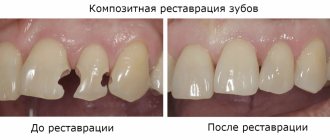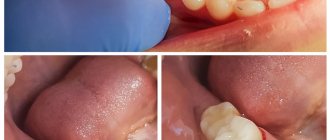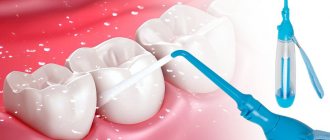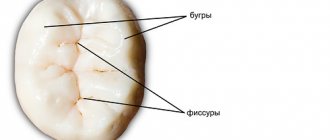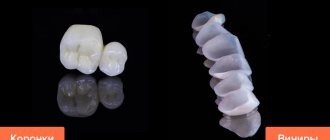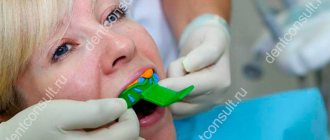There are a number of reasons (trauma, caries, short crown) why only the root and a small part of the crown remain from the tooth, and the rest of the dental tissue is lost. Until recently, in this case, fillings, a prosthesis were installed, or a tooth was removed. Currently, it is possible to use restoration options that allow you to recreate the original appearance of the tooth. The restored tooth looks natural and aesthetically pleasing. An important condition is that the root must be intact. Computer technology is used to create a copy of the crown of a future tooth.
Possible contraindications
Augmentation is a fairly new technology that allows you to completely restore a lost tooth. It is not as painful as other methods, and allows you to save the tooth, even if there is only one root left.
Damaged teeth are not only a cosmetic problem, but also an excellent environment for the development of infectious diseases. The cause of injury may be temporary wear, chips, cracks or carious processes. All of these are indications for the procedure.
A contraindication to extensions is the presence of an allergy to the materials used for manipulation. It is also recommended to refuse the procedure in case of severe pathologies of the oral cavity and dysfunction of the temporomandibular joint. Some techniques have their own contraindications, of which the doctor must notify the patient.
Before and after extensions
Previously, implants were used for restoration, but thanks to modern advances, doctors can build up damaged areas of tissue. The following types of recovery exist:
- extension with composite materials;
- filling;
- pin restoration;
- installation of veneers or lumineers;
- crown covering.
Fresh questions about the teeth extension service in Kirov
- In
Vladimir asks a question to the Ideal clinic, April 04, 14:15 Treat a child’s teeth under general anesthesia if the child has a delay in speech development, a 7-year-old boy. - L
Lyudmila asks a question to the Ideal clinic, October 21, 2021, 10:32 pm Hello, do you treat children’s teeth under general anesthesia?
- L
Lyudmila asks a question to the clinic Pediatric Dentistry Med Kids, October 21, 2021, 10:31 pm Hello, you treat children’s teeth under general anesthesia
- IN
Vladimir asks a question to the clinic Dentistry Vyatka-dent, August 17, 2021, 16:28 Removing braces, installed in Georgia (price)
Photopolymer method
The simplest extension method is the use of photopolymer materials. This technique allows you to completely hide the cavity where caries was treated and restore the natural appearance. For restoration, only those materials are used that are compatible with gum tissue and do not cause irritation to the mucous membrane.
Most photopolymers contain fluorine. This component allows you to restore enamel even after serious damage. The main advantage of this technology is that there is no need to remove the root. To carry out the extension you will only need one session with the dentist.
Before and after extensions
Composite materials are used for extensions in cases where it is necessary to eliminate a chip or remove a stain on the enamel. It will be very difficult to distinguish the extended tooth from the rest.
Installing a seal
For restoration using filling, special compounds are used that do not damage either the mucous membrane or the enamel. They practically do not differ in color and texture from ordinary enamel.
Modern filling materials make it possible to completely imitate the natural transparency of tooth enamel. The advantages of this type of extension:
- the ability to hide minor defects;
- rapid restoration of chewing function;
- nerve preservation;
- the ability to adjust the shape and size of the tooth.
In the video it looks like this:
It is important that the doctor uses high-quality materials, otherwise the filling may simply fall off.
How long does dental prosthetics take?
Stages of dental prosthetics
Timing of dental prosthetics
What to do after prosthetics?
Today, dentists are ready to offer various options for smile restoration - implantation, inlays, crowns, bridges, removable/fixed dentures, veneers. Prosthetics are done for various reasons, but many are interested in the question: how long does dental prosthetics take?
Extension on a pin
Pin restoration is used when it is necessary to create support. The pin itself can be made of fiberglass or titanium. The use of such a technique will be justified only if the degree of destruction is more than 50%.
The restoration process occurs in the following stages:
- radiography;
- drawing up a model on a computer;
- pin installation;
- formation of the upper part of the tooth.
If all manipulations are carried out correctly, the service life of the tooth is extended for many years. A crown can be placed on a pinned tooth.
Veneers and crowns
Veneers are used for artistic restoration. These are thin plates that are made directly from a patient’s impression from a ceramic composition.
The natural coating is almost completely ground off, and veneers are attached in its place. A type of such plates are lumineers; they are installed without preliminary turning. This is the most gentle method, but the cost of tooth extension using this method is quite high.
Restoration with veneer
Restoration with a crown is resorted to in cases where other methods are ineffective. Due to the fact that the tooth is severely damaged, it can break off directly during eating. To avoid this and protect it from complete destruction, a crown is installed.
Depending on the material, artificial crowns vary significantly in price. The most common option for the chewing part is metal-ceramic products. For the frontal area, crowns made of metal-free ceramics can be used.
Removable dentures (traditional)
- When to place: in the absence of any number of teeth - one, several or all.
- Duration and features of wearing: temporary prosthetics, the prosthesis will last 3-5 years. They are relevant if there are contraindications to fixed prosthetics - pregnancy, in childhood, with serious diseases of the body (when it is not recommended to give anesthetic injections and perform surgical interventions), with a small budget for treatment.
REPROSTHETICS WITH ACRYLIC PROSTHETICS - RUB 200,000.
Re-prosthetics with an acrylic bridge on a metal frame (all included) up to 12 units.
Save RUR 30,000. Call now or request a call
As a rule, removable dentures supported by gums or remaining teeth cannot provide high aesthetics, since their fastenings in the form of hooks (especially metal ones) are visible from the side. It is difficult to chew food with them, because... fixation is unreliable. Most removable dentures dent due to softness, loose fit, or rub the gums to the point of ulcers and injure the supports. Also, structures often fall out of the mouth while eating or talking. Therefore, patients have to use a cream to adhere the base to the gums (for example, Corega or Protefix).
Removable prosthetics for single defects
If we consider the situation that the patient is missing only 1-2 teeth along with the root, then the orthopedic dentist can offer “butterfly” prosthetics. This is a miniature orthopedic structure consisting of artificial crowns, surrounding artificial gums and hooks along the edges, which are fixed to adjacent dental crowns (natural). It is very difficult to chew food normally, so you should choose this solution only on a temporary basis.
If you don't have a lot of teeth
Here they install more massive versions of removable structures - for example, clasp ones (on hook-clasps, clasps-attachments or telescopic crowns). Their advantage is that they distribute the chewing load quite well due to the presence of a metal arch - a clasp, and also have a small palatal bridge.
For the same indications, you can install classic acrylic removable dentures with hooks for fixation on the remaining teeth. Or nylon - they are more convenient, because... the material is elastic, but stretches over time and cannot be repaired. Removable structures Acry-free (“Acry-free”), Quattro Ti (“Quadrotti”), and sandwich dentures are considered more comfortable to wear compared to conventional acrylic ones.
It is worth mentioning separately about “Quadrotti”, which are considered metal-free analogues of clasp ones. They, like the “clasps”, do not have a large palatal overlap, but only a thin bridge. The remaining removable structures will be equipped with a massive sky - and the fewer units left in the row, the more massive it is.
Removable prosthetics with complete edentia
If all the teeth are missing along with roots suitable for prosthetics, clasp structures can no longer be placed, just like sandwich dentures. The patient can choose between other removable ones - acrylic, nylon, polyurethane and Acry-free. Since the prosthesis is attached only to the gums and only due to the “suction cup effect,” the quality of fixation of such products leaves much to be desired. Many patients often say that they cannot get used to the massive prosthetic structure (because they begin to feel sick or produce a lot of saliva) or are completely unable to chew with it. That is, such an artificial “jaw”, at best, can provide the beauty of a smile, but you can forget about functionality.
Features of restoration of chewing molars
The choice of a specific augmentation technique depends on whether the nerves are preserved or not. To restore teeth with nerves, composite materials with glass ionomer spacers can be used. There is also an orthopedic prosthetic method. It involves installing ceramic inlays. The doctor is faced with the task of not only restoring, but also preserving the pulp.
Extension of pulpless teeth is carried out using:
- fiberglass pins;
- composite materials;
- metal stump inlays;
- zirconium crowns;
- ceramic restoration inlay.
When a tooth is left without pulp, its strength decreases, so doctors recommend installing a metal-ceramic crown. In this case, making restoration is practically not painful, since the nerves are dead.
Correction with crowns
If the tooth is severely damaged, but the root is not destroyed, correction with crowns is used. The technique is implemented on the front and chewing teeth. Crowns are installed when it is impossible to install a filling - when the carious cavity is too extensive, when the tooth is destroyed by 70% or more.
How to install a crown:
- The tooth is prepared, freed from affected tissue, and the walls are ground down;
- An impression is made and sent to the dental laboratory.
- The finished crown is tried on and installed.
Modern technologies make it possible to obtain crowns that perfectly imitate the transparency, shade and texture of natural teeth.
Cost of the procedure
The price of teeth extension from the root can vary. It depends on the location of the clinic, the qualifications of the specialist, the degree of tooth decay and the materials used to restore it. For example, the price of tooth extension on a pin varies from 400 rubles. for an anchor pin, up to 2,000 for a stump inlay. Restoring a chipped front tooth will cost about 1,500 rubles, and to restore half of it will require 5,000 rubles. They can only tell you exactly how much tooth extensions cost directly in the clinic itself after an examination.
In Moscow, extensions with composite materials will cost about 7-8 thousand rubles. This cost includes pain relief, strengthening with a pin and restoration with filling materials. Partial extension will cost from 2.5 to 3 thousand rubles.
To grow a tooth in dental clinics in Kirov
- Dentistry Vyatka-dent
- Surikova street, house 27
- +7 (8332) 54-… show all
- Mon-Fri 8:00–20:00; Sat 8:00–13:00
4.3 ratings: 7
- Ideal
4.2 ratings: 10
- Dentistry dynasty
4.1 ratings: 10
- Dialit
4.4 ratings: 5
- Copper
4.0 ratings: 8
- Gamma-dent
4.1 ratings: 8
- Avanta-dent
4.2 ratings: 5
Patient reviews
My father asked me to find out how much it costs to put a pin and build up a tooth. I went to the clinic, where they explained everything to me, and it turned out that it was not as expensive as I thought. The main thing is that the pin will make the tooth more stable, and the crown will help it hold on without falling apart.
Valeria
For a very long time I did not dare to go to the dentist to get extensions done at the site of the chip. After the examination, the doctor advised which method was best to use. Six months have already passed since the restoration of the tooth, it looks as natural as possible.
Sofia
I recently had a tooth augmented with a crown.
About 50% was completely affected, so a pin was used to strengthen it. The procedure itself was not painful since the pulp was removed. To make the extension look natural, the doctor advised to insert a metal-ceramic crown. The clinic gave me a guarantee on it. Varvara
Indications for removal along with the root
No dentist will remove a tooth just like that, since each one is important for the normal functioning of the dental system - doctors still try to preserve them. To do this, fillings or restorative inlays, crowns, pins and stump inlays are placed in the root canals. So is it necessary to remove tooth roots before getting dentures? Yes, indeed, sometimes situations arise that removal is the only option, otherwise complications are possible - up to infection of the jaw bone or loss of all units in a row.
Let's consider cases when deletion is indispensable:
- the presence of vertical cracks in the roots,
- irreparable perforations in the root wall or in the bifurcation area (the place where the roots begin to branch under the crown),
- presence of a piece of dental instrument in the root canal that cannot be removed,
- chipping of the crown deep under the gum: in this case, placing a filling or core inlay may be problematic due to the damp environment around - such a restoration will not last long,
- the presence of neoplasms under the roots (cysts, granulomas) that cannot be eliminated without removal,
- destruction or complete dislocation due to injury: blow, bruise, gnawing something hard,
- inability to go through root canals with an instrument due to their non-standard shape,
- osteomyelitis of the jaw: if osteotomy (cutting off) of pathological areas of the bone is required,
- severe loss of bone and gums against the background of the late stages of periodontitis and periodontal disease: here the teeth become very mobile, and tartar builds up along the roots - an infectious focus arises, which leads to inflammation and toxic damage to the surrounding tissues (gums and jaw bone).
